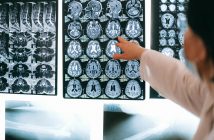A spiritual figurehead walks into a pizzeria and says, “Make me one with everything.” A quizzical look regarding the money owed follows the transaction, and the clerk simply states, “Change comes from within.”
This joke is somewhat out of date (who uses cash nowadays?), and perhaps unrealistic (unless the pizza is topped with a vegan-friendly dairy alternative, Gung Ho! Gung Ho! GO, GO, GO!), but the sentiment stands.
The word ‘mindfulness’ may seem intimidating, but it’s really just the concept of thinking about your actions and their effect on, well, everything. OK, that’s relatively intimidating, but bear with me.
In recent years, there has been a rise in ecological awareness. Global warming, overconsumption, and a more recent push for reduced plastic usage/abusage are topics that fill our news feeds daily, and it can get a little overwhelming. Worry not, reader, you need not turn your apartment into a permaculture palace, or join the plastic police just yet.
Some simple modifications can be made to our day-to-day routines such as recycling and repurposing waste; and other changes which might influence the future generations to come begin in the kitchen.
For starters, a story.
Once upon a time, a rather studious man on a quest to get a little healthier was watching an admittedly “rather boring” seminar about oatmeal. As that was being digested, another video, Gary Yourofsky’s ‘Vegan Activist DESTROYS Ignorant Reporter’ popped up. Unperturbed by the clickbait title, our protagonist, Robin Salinas, saw it was only fourteen minutes, and thought “why not.” Not often does taking the bait and clicking lead to anything beyond minor disappointment, but Robin clicked well.
“Wow. That guy was amazing. So wise, so smart. Everything he said was just so right!” Robin exclaims, pouring us another hot infusion of floral health liquid. “I thought he looked so healthy, so secure. So that’s it, I transitioned from a rather boring seminar about oatmeal to a video about veganism, and it changed my life forever.”
One of the teething problems found in the transition to a plant-based diet is maintaining adequate nutritional intake. The few “VEGANUARY!” “VEGTEMBER!” or “MORRISEY IS MY MATE” challenges, and subsequent WeChat groups I’ve been involved, with are rife with complaints of feeling faint, cranky. and straight-up hungry, all the time.
Be smart, use your noodle!
Training as a marathon runner at university meant that Robin had ample recognition of the food groups, and what nutrients were needed to replace those lost in a plant-based diet. He also knew how to train the body, and the self-discipline that making change requires. With a thirst for knowledge and new mindful outlook on what was entering his system, Robin delved deeper into the who’s who and what’s what of human herbivore history.
“A lot of people think that because protein is for muscle, we need to eat muscle. They never think ‘I need to eat skin to grow skin, I need to eat hair to grow hair, biting my nails will grow my nails.’ The amino acids are all around the vegetable queendom, so you just need to be smart.” After a brief pause, he went on to decode the importance of “efficient absorption.” Eating is apparently not as important as the periods of abstinence between meals.
Roots and Shoots
In the early stages of human evolution as hunter-gatherers, we’d forage and hunt, eat, wait, repeat. Natural food preservation methods have progressed through the ages, and prototype artificial refrigeration solutions were discovered around the mid 18th century and tinkered with until the 1940s when home refrigeration units became commonplace. They were no longer a luxury but a household essential. This, and the advancement in food packaging solutions, meant that the shelf life of ready-to-eat products increased, as has consumption ever since.
Reminiscent of our ancestors’ ancestors’ feeding habits, intermittent fasting is the idea of splitting a twenty-four-hour day into two periods of eating and resting: eight hours in which consumption can happen, and sixteen hours of rest. “You can skip breakfast, or dinner, it’s up to you. I stop eating at four because I don’t need any more food.” This debunking of the three-square-meal-a-day mantra we may have been raised with does not apply to pregnant women, children, or practicing athletes, but is the “optimum method of consumption for an optimum body.”
Robin breaks it down: “If, for instance, you make a good smoothie, you are drinking up to ten ingredients, your body has to decide how to process each thing.” If we’re not giving ourselves enough time to utilize the full potential of what we’ve eaten before the next nutritional data-dump, our body will mostly waste the good stuff, and store the rest in our bellies and bingo-wings.
Maintaining self-restraint is often easier said than done, but analogies and metaphors can help us reframe certain situations for easier comprehension. “If a car needs more gasoline, you can keep filling until the tank is full, and the tank will take no more.” Robin continues, “The human body is a different machine entirely; you can eat, and eat, and eat.”
Sometimes our cravings get the better of us, and it’s important to know they can happen for a multitude of reasons. Food addictions, dependencies, and deficiencies aside, the root causes can go back to before we were even born.

Mother’s Milk
A well-managed, properly planned plant-based diet will provide the optimum fuel for your engine – this is a fact. There are misconceptions that this diet may not be suitable for expecting mothers (dispelled by the American Dietetic Association), as the biggest concern is always where to get protein. The full range of nutrients needed to live healthily can be found across the “vegetable queendom” and foods such as quinoa, hemp, and amaranth combined with nuts and pulses will provide all the amino acids needed to sustain energy and aid muscle development.
With regards to direct ingestion, a baby’s kidneys can’t handle more salt than the recommended one gram a day, or for toddlers two grams. Sugar is equally harmful to newborns, if not more so. White sugar is refined and loaded with dangerous chemicals while holding zero nutritional value. “Sugary treats” can make a baby feel full without any dietary benefits, introduce harmful bacteria causing early tooth decay, and lead to heart problems and obesity in later life.
To have a “sweet tooth” is a culinary curse (or blessing, you can decide) many of us are afflicted with, and to halt bad habits before they begin, Robin suggests using natural replacements such as agave syrup, stevia, and cacao.
“You can make quinoa sweet, or savory. You can turn avocado into a puree, chocolate, or cake. There are so many ways natural food that some consider boring or bland can actually taste delicious, without an artificial flavor explosion.”
Developing children might seem reluctant to eat home-prepared food, but it’s doubtful their tastebuds are too discerning at such an early age. Superfoods such as broccoli and spinach are often uninviting due to the methods in which they are prepared, but can easily be “disguised” in other dishes, such as mashed potato, or a blended soup. Incorporating ideas from the “rainbow diet” and making meals as colorful or visually appealing as possible can also help with fussy eating. We are told not to play with our food, but why not have your kids prepare their own meal-time masterpiece?
What’s going on?
EAT is the “science-based global platform for food system transformation,” a global non-profit foundation with a mission to change the way we view food consumption. In January 2019, a summary of the EAT-Lancet commission was released, a data-rich compendium of targets for worldwide healthier diets and sustainable food production, and pushed forward with attainment targets. In brief, thirty-seven subject-specific scientists have stated: “a diet rich in plant-based foods and with fewer animal source foods confers both improved health and environmental benefits.”
What they didn’t say is that we have to toss our tomahawks or banish our burgers just yet. In a nutshell, halving meat consumption and doubling plant-based food intake can achieve monumental planetary gains.
“Meatless Mondays” was a movement first introduced in World War One and revived in 2003 as a non-profit public health initiative. The concept is relatively simple – cut meat for one day a week. Why Mondays? Research has suggested that people might be more open to trialing healthy-habits at the beginning of the week, as an opportunity to “reset” after any potential lapses over the weekend. It also makes for a great hashtag eco-brag. Taking it one step further, the “flexitarian diet” is an easy way to cut down on animal-based products, without feeling guilty about going carnitas-crazy the following #tacotuesday.
One of the things we love about being an expat in Beijing is not only the variety of foods on offer from around the world, but the ease with which they can be attained. With an increase in those opting to cut the meat out of their diets, vegetarian-friendly options have progressed considerably since the days of “Sorrowful Soup Of The Day” or “Soggy Spare-Veg Salad”. From mouth-watering Indian-inspired bar snacks (Side Street) to five-star, entirely meat-free menus (King Joy), Beijing is actually a great city in which a little dietary shift can be embraced.
While I’m ashamed to admit I’ve lapsed more often than I’d like, I fashioned myself a “social-carnivore” mindset after spending a considerable amount of time wining and dining with my veggie-mates:
“If you’re ordering, order for one of your veggie-mates. Also, if there’s a vegetarian at the table, you’re eating vegetarian. If there’s a vegan at the table, you’re eating vegan.”

Prana – How To Attain Your Own Slice Of Life
Robin believes that to make the most of life, we need to eat life. Not the life of another animal, but the life provided by mother nature. Prana, or Chi, or… “The Force” is the life-giving force supplied by the air, the sun, and the breath of the earth.
“Let’s say you have a tree, with an apple, and it’s still warm from the sun. It still has life, but life intended for us to eat. Let’s say you get the apple, cut the apple, put it in an apple pie. You take the pie, cook the pie, freeze the pie. Weeks later, you remember the pie, defrost the pie, cut the pie, and warm the pie in the microwave. Where’s the life of this pie?”
“We take food from the earth, and from trees, and trees are clever; they have patience. We are here for maybe ninety years, trees, much longer. They sleep by the seasons and communicate through the soil. We eat the fruits, and we spread the seeds. This is the system of the planet.”
Our Internal Rainforest
When we hear about bacteria, we might grimace at the image of nasty dirt-associated germs, making us ill and ruining our fun, but not all bacteria are bad.
“In Chinese kindergartens, they’re obsessed with cleanliness. ‘Don’t touch this, don’t touch that!’ The problem with this is that children are living in a bubble which will actually lead to more diseases because there’s no chance to develop an internal defense mechanism.”
Nature produces bacteria, and we need bacteria to function. Our gut produces friendly bacteria that aids digestion, which can be further helped with naturally fermented foods such as sea-salted sauerkraut and kombucha.
“The inside of our body is a rainforest, and we have to keep the rainforest alive.”
Composting is when alkaline-rich decomposing fruit and vegetables are used to make nutrient-rich, natural fertilizer for the soil in which our food is grown. The same applies to our internal rainforest. Fiber is one of the most beneficial nutrients required for the proper digestion of foods and helping us feel full. High fiber foods such as beans, lentils, and collard greens not only help us feel full but keep our internal movements flowing.
“The bacteria in our body send messages to the brain, and the food we eat grows the bacteria needed to break it down. We need to grow bacteria that like fiber, and this can only be found in the vegetable queendom. There is no fiber in animals. Our body has an internal temperature of 36 degrees, about the same as outside in the summer. What would happen if you put a piece of meat on the ground outside in the summer? It will rot. There will be worms. It’s not pretty.”
Food for thought
“We should listen to our body but a healthy body. If you drink tequila, you’ll want tequila. If you eat meat, your carnivorous bacteria have a conversation with your brain: ‘Hey brain, we need more meat!’, and the brain will say ‘Don’t worry, there’s more meat coming!’ while shouting at us ‘Hey you! Eat more meat!’. We will listen to our brain, and say ‘I want more meat,’ and as a reward, our mind will release a little dopamine to keep us happy. The same applies to food that is actually doing good. Listen to your body, but only when it’s healthy.”

This article appeared in the beijingkids September 2019 Family Foodies issue
Photos: Courtesy of Robin Salinas




